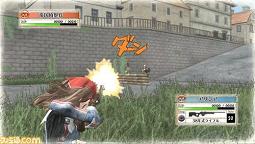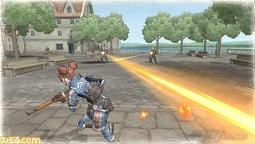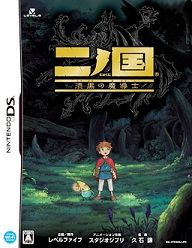Valkyria Chronicles
PlayStation 3
Reviewed: 10/02/08
 The awesome story of the Seventh Platoon comes alive via strategic RPG warfare in Valkyria Chronicles.
The awesome story of the Seventh Platoon comes alive via strategic RPG warfare in Valkyria Chronicles.
From watching videos and looking at screens, it can be somewhat hard to tell where exactly the “RPG” fits into Valkyria Chronicles. No doubt about it, this is a tactical RPG. It is not “part FPS,” it is not “part third-person shooter,” and it has only the slightest touch of an action game. Though, this is not to say that it doesn’t take grand leaps away from SRPG convention — because it definitely does.
The core setup is like Fire Emblem and Disgaea, with battles consisting of an enemy phase and player phase. In each phase, a side is given so many command points with which to perform its actions. One command point enables the player to move any unit and act one time with that unit; any unit can move and act once per every time a command point is spent on him/her, though some weapons and items are restricted to one use per phase, and a unit’s movement range will be less each time it is moved within the same phase. As one could guess by experience with other TRPGs, an “action” will usually be an attack with one of the unit’s equipped weapons, but it could also be curative.
The slight touch of action mentioned above comes during the player’s movement of units around the battlefield. Instead of this being a quick and safe process like in traditional strategy RPGs, opponents of the right classes within range will fire at a moving unit. That said, much like a real war, it’s best to get where one is going in a hurry. Unlike real war, however, all shooting is done with time standing still. Whenever the player hits R1, the character will stop and ready its equipped weapon. Enemies will also stop firing during this time; the player has literally as much time as desired to cycle through options, take aim at different enemies, and so on. Again: there is no action-type gameplay involved with the shooting. Just as the player of any other turn-based RPG does not need to pull off crazy amount of button presses to strike a wombat with a sword, all that’s involved with the shooting here is taking all the time in the world to place some crosshairs, perhaps stopping to make oneself a sandwich, then pressing X once. If a player is discontent with what’s available, however, the action can be canceled, but this means that the enemies will open fire once again, so one had best get running or end the turn.
 |
| Hiding in the grass is a good way to make it difficult for opponents to hit you. |
What’s additionally excellent about this is that it adds a stronger defensive aspect to the battles, often absent from tactical RPGs. Sure, in past games it has been important to position a unit with its back pointing away from foes, take the higher ground, and such, but VC takes it to another level. That is to say, the act of defending is more “active.” Knowing that one’s units (at least those of the scout, infantry, and support classes) will, to some extent, try to ward off intruders in real time gives players of Valkyria a fresh take on the defensive aspect of an SRPG. One doesn’t just “gear up” for defense with better equipment or “Counter-Tackle,” one is actually playing defense to a greater extent than in previous SRPGs.
Unlike many tactical games, Valkyria Chronicles requires tactics. Gloriously, however, it does not confine the player to figuring out a single pattern or strategy per mission. Most missions (with some story-driven exceptions) can be completed with a strategy of the player’s devising, not necessarily the strategy the game wants the player to use. Furthermore, no single class dominates the game. Every class has strengths, flaws, and a special use. For example, scouts are the most adaptable overall, but a team full of scouts will have huge weaknesses.
A few gripes come on the battlefield, most notably in the form of the terrifying innacuracy of anti-tank personnel. Sometimes, even mere meters away from a target, they’ll miss by approximately half a football field, as if they were aiming at mothereffing space. It’s fine and realistic for any given unit to miss somtimes, yeah. But seriously, some of the shots with the anti-tank characters can get ridiculous. With other classes, aiming around corners can be a little tough, due to some camera issues that show up mostly in urban warfare. The character can see (and be seen and shot-at) and even point his/her gun around a corner sometimes, but since the third-person camera’s invisible barriers haven’t caught up by the time the player hits R1, a shot can’t be taken. That, or some thin pole will be in the way, but it’s just big enough that invisible barriers hovering around it will block the player’s shots. It feels like a ripoff, since the player can clearly see the gun pointing around the corner, but since the camera can’t catch up, the player can’t shoot. This happening sucks extra hard, because the player must then cancel the action, which brings in the slight lag between when the unit can move again, hence sometimes costing the character some more HP via the enemy pelting him/her with a few more shots. It can get frustrating, not in the challenging way, but in the “Ugh, this mechanic is slightly broken” way.
 |
| While not the “best” on the technical front, the game’s visuals are stunning in every scene, and among the best of all time, artistically. |
It would also be nice to be able to opt out of having the “POTENTIAL!” message and video flash on screen every time one happens. In certain high-tension situations, the message showing up to inform the player of a character’s special ability turning itself on can interfere. Take a look at it kicking my ass, for example, in this video (skip to 3:07 for what I mean. Side note, Vyse from Skies of Arcadia comes in afterwards).
Back to positive things, VC steers away from convention again by way of the characters not really having equipment in the traditional sense. The player does buy new uniforms for slight defense boosts (into which everyone automatically uprades upon purchase), new parts for tanks, and weapons for each class, but the way it is handled takes far less time than usual games of this type. Experience points are gained at the end of battle, and apply to the whole platoon. Leveling up is done one class at a time, using these group-owned points. For example, when the player chooses to use 62,543 EXP (hypothetical number) to level up the snipers, it means every sniper is now a level higher. Watch our video here for a visual explanation.
The game’s setting and technology are similar to what was around during World War I and II, but with a small number of fantasy additions such as frickin’ huge megatanks and occasional showing up of nonsensical “Valkyria-people” magic. It’s a wonderfully refreshing break from the two main settings that 97 per cent of RPGs seem to get filed into, those being medieval fantasy and science-fiction.
 |
| Some enemies will fire at moving allies within range. |
Valkyria Chronicles is distinguished by several factors, but among them perhaps unexpectedly are its story and characters. Its tale evokes plenty of emotion, even from those who generally aren’t affected game stories (me). The characters are excellently developed, likeable, well-acted and well-scripted. While scattered elements of these will be labeled as cliché, the plot is executed well, the story is very enjoyable, the cast is quite likeable, and all of the above feel extra fresh because of the unique setting and scenario.
The game looks incredible; it’s a perfect combination of Japanese anime stylings and current-gen power. Things come together incredibly well, and the game’s unique look works to its benefit in every battle and plot scene. Sakimoto’s music usually sounds like the characters of the game in question are gonna start a huge war anyway, so his style fits perfectly into Valkyria Chronicles. Very nice and fitting audio, though grind lovers might get a bit tired of the tracks that play during the skirmishes. The only real downpoint is that the best songs are so rare and/or only a one-time appearance, practically forcing players to obtain the soundtrack in order to enjoy the bulk of the game’s music.
Another thing Valkyria has going on for it is challenge. Even in the first playthrough when “Normal” is the highest difficulty available for a given battle, this is a legitimately difficult game. Several of the battles will require more than one attempt, for sure. Moreover, there is no way to simply level grind one’s characters to superstatus. Even when playing through the most difficut skirmish available and snagging the seemingly high amount of EXP per battle, the jumps to each class’s next level are pretty big. Not only that, but even when S-ranking a mission in the quickest way possible, the whole process of going through the loop of steps involved can take a long, long while (not helped by the fact that skipping the mission briefing isn’t possible). As if the above weren’t enough, there is a level cap of 20 anyway. So near the end of the game, all things will begin to balance out, even for those who’ve spent inordinate amounts of time level grinding. Adding to all this, those who still end up finding the game easy will be delighted with the punishing Hard Mode, available after clearing the game. As of review time, the game is also receiving great support in the way of downloadable content.
Valkyria Chronicles is an amazing experience. It’s rare, these days, that a game can make such a huge departure from its genre’s roots and yet keep the best things about it. It revolutionizes strategy RPGs in such a way that it can be appealing to fans of the subgenre, newcomers, and perhaps even sworn-off non-fans of it. The best thing that could happen now would be a sequel.
-Heath Hindman
| Score Breakdown | ||
| Overall Legendary Out of 10 See our Review Criteria |
Gameplay | Legendary |
| Story | Excellent | |
| Graphics | Legendary | |
| Sound/Music | Very Good | |
| Replay Value | Great | |
| The Verdict: Legendary |
||








